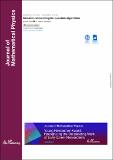| dc.contributor.author | Rossi, Zane M | |
| dc.contributor.author | Chuang, Isaac L | |
| dc.date.accessioned | 2024-09-19T20:40:50Z | |
| dc.date.available | 2024-09-19T20:40:50Z | |
| dc.date.issued | 2023-12-01 | |
| dc.identifier.uri | https://hdl.handle.net/1721.1/156910 | |
| dc.description.abstract | The study of classical algorithms is supported by an immense understructure, founded in logic, type, and category theory, that allows an algorithmist to reason about the sequential manipulation of data irrespective of a computation’s realizing dynamics. As quantum computing matures, a similar need has developed for an assurance of the correctness of high-level quantum algorithmic reasoning. Parallel to this need, many quantum algorithms have been unified and improved using quantum signal processing (QSP) and quantum singular value transformation (QSVT), which characterize the ability, by alternating circuit ansätze, to transform the singular values of sub-blocks of unitary matrices by polynomial functions. However, while the algebraic manipulation of polynomials is simple (e.g., compositions and products), the QSP/QSVT circuits realizing analogous manipulations of their embedded polynomials are non-obvious. This work constructs and characterizes the runtime and expressivity of QSP/QSVT protocols where circuit manipulation maps naturally to the algebraic manipulation of functional transforms (termed semantic embedding). In this way, QSP/QSVT can be treated and combined modularly, purely in terms of the functional transforms they embed, with key guarantees on the computability and modularity of the realizing circuits. We also identify existing quantum algorithms whose use of semantic embedding is implicit, spanning from distributed search to proofs of soundness in quantum cryptography. The methods used, based in category theory, establish a theory of semantically embeddable quantum algorithms, and provide a new role for QSP/QSVT in reducing sophisticated algorithmic problems to simpler algebraic ones. | en_US |
| dc.language.iso | en | |
| dc.publisher | AIP Publishing | en_US |
| dc.relation.isversionof | 10.1063/5.0160910 | en_US |
| dc.rights | Creative Commons Attribution | en_US |
| dc.rights.uri | https://creativecommons.org/licenses/by/4.0/ | en_US |
| dc.source | AIP Publishing | en_US |
| dc.title | Semantic embedding for quantum algorithms | en_US |
| dc.type | Article | en_US |
| dc.identifier.citation | Mohua Das, Joshua David John Rathinaraj, Liviu Iulian Palade, Gareth H. McKinley FRS; Laun's rule for predicting the first normal stress coefficient in complex fluids: A comprehensive investigation using fractional calculus. Physics of Fluids 1 January 2024; 36 (1): 013111. | en_US |
| dc.contributor.department | Massachusetts Institute of Technology. Department of Physics | |
| dc.relation.journal | Journal of Mathematical Physics | en_US |
| dc.eprint.version | Final published version | en_US |
| dc.type.uri | http://purl.org/eprint/type/JournalArticle | en_US |
| eprint.status | http://purl.org/eprint/status/PeerReviewed | en_US |
| dc.date.updated | 2024-09-19T20:35:26Z | |
| dspace.orderedauthors | Rossi, ZM; Chuang, IL | en_US |
| dspace.date.submission | 2024-09-19T20:35:30Z | |
| mit.journal.volume | 64 | en_US |
| mit.journal.issue | 12 | en_US |
| mit.license | PUBLISHER_CC | |
| mit.metadata.status | Authority Work and Publication Information Needed | en_US |
